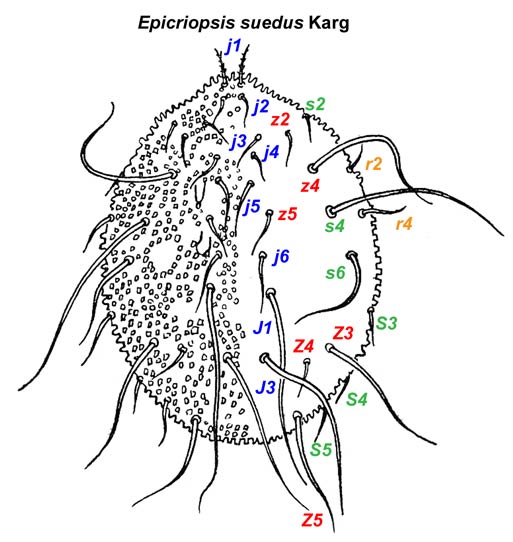| |
Epicriopsis
Taxonomic Position
Cohort Gamasina
Subcohort Dermanyssiae
Superfamily Ascoidea
Family: Ameroseiidae
Berlese
Epicriopsis Berlese - 8
described spp.
Diagnostic characters:
-
Dorsal shield well sclerotized, entire or incised, ornamented with tubercles and bearing <25
pairs of often elongate, thickened and barbed setae, setae J5 absent
-
Sternal shield often reduced
to 2 pairs of setae, st3 on shield or on platelets
-
Corniculi distally toothed,
chisel-like, or weakly membranous
-
Chelicerae with membranous lobe
-
Tectum
simple, smoothly subtriangular to acuminate, often with a well-developed median
spine
-
Genu II with 2 ventral setae
-
Palp apotele 3-tined
-
Tarsus I with claws
and empodium.
Ecology. Epicriopsis walteri
Halliday lives in rainforest floor litter in Australia and can be reared on
fungal hyphae. Other species are found in a variety of litter types and
are assumed to be fungivores.
Similar taxa.
Within the Ameroseiidae, species of Epicriopsis are most likely to be
confused with those in Ameroseius that have relatively long setae;
however, species of Ameroseius have 29 pairs of setae on the dorsal
shield, as opposed to 24 or fewer in Epicriopsis. Dorsal shield
hypotrichy is also present and tubercular ornamentation is also characteristic
of Podocinidae and Epicriidae.
Key to adult females of
soil/nest inhabiting genera
1. Dorsal shield
with marginal ring of tubercles bearing setae j5, z2, z4,
z6, s5, Z2, and S5; forest litter in eastern
Australia...................................................................................
Asperolaelaps
- Not
as
above...............................................................................2
2. Sternal shield
with 3 cog-lkie circular ornaments; dorsal shield setae short, club-shaped to
spatulate; setae j1 on bifid
vertex...............................................................................
Seritympanum
- Not as
above...............................................................................3
3. Pretarsus
I without claws..........................................................Ameroseiella
- Pretarsus
I with claws..................................................................4
4. Dorsal shield
with 24 or fewer pairs of
setae.................................................. Epicriopsis
- Dorsal shield
with 27-29 pairs of setae..........................................5
5. Dorsal
shield with 27 pairs of setae; genu II without ventral setae...................Brontispalaelaps
-
Dorsal shield with 29 pairs of setae; genu II with 2
ventral setae....6
6. Anal
shield with 3 setae; genu III with 1 pl seta; palp apotele
3-tined..............................Ameroseius
- Ventrianal shield
with 5 or more setae; genu III with 2 pl seta; palp apotele 2-tined.......Kleemannia
References
Elsen P, Whitaker
Jr JO. 1985. Seritympanum, a new genus of Ameroseiidae (Acarina,
Mesostigmata) taken from rodents in the United States: Including descriptions of
three new species in the genus. Acarologia 26: 117-122.
Evans GO. 1963. The
genus Neocypholaelaps Vitzthum (Acari : Mesostigmata). Annals and
Magazine of Natural History (13th series) 6: 209-230.
Halliday RB. 1997.
Revision of the Australian Ameroseiidae (Acarina: Mesostigmata). Invertebrate
Taxonomy 10: 179-201.
Hughes AM. 1976.
The Mites of Stored Food and Houses. Ministry of Agriculture, Fisheries and
Food, Technical Bulletin no. 9. (Second edition) (Her Majesty's Stationery
Office, London). 400 pp.
Seeman OD. 1996.
Flower mites and phoresy: The biology of Hattena panopla Domrow and
Hattena cometis Domrow (Acari: Mesostigmata: Ameroseiidae). Aust J Zool
44: 193-203.
Seeman OD, Walter
DE. 1995. Life history of Afrocypholaelaps africana (Evans)
(Parasitiformes: Ameroseiidae), a mite inhabiting mangrove flowers and phoretic
on honeybees. Journal of the Australian Entomological Society 34: 45-50.
